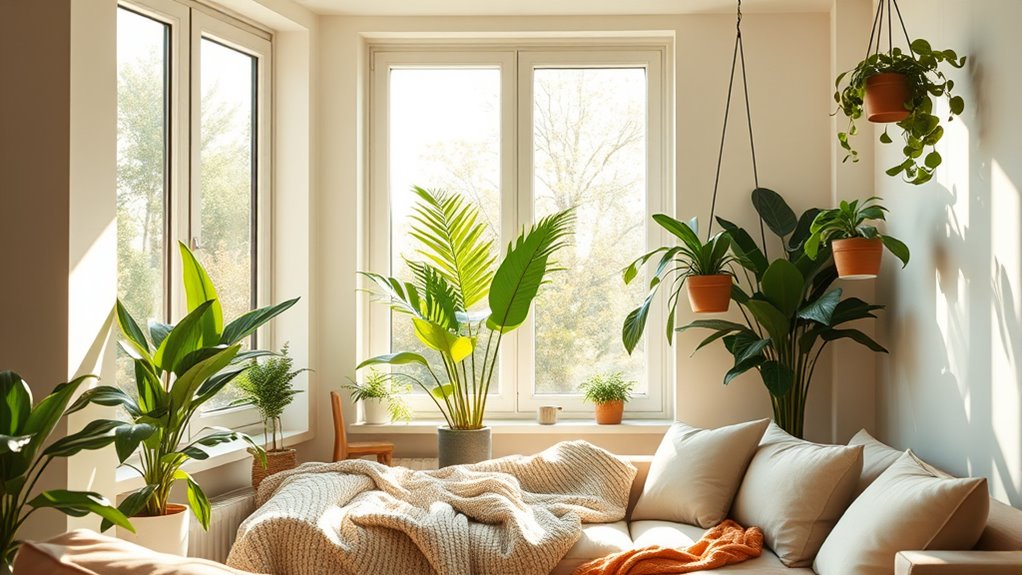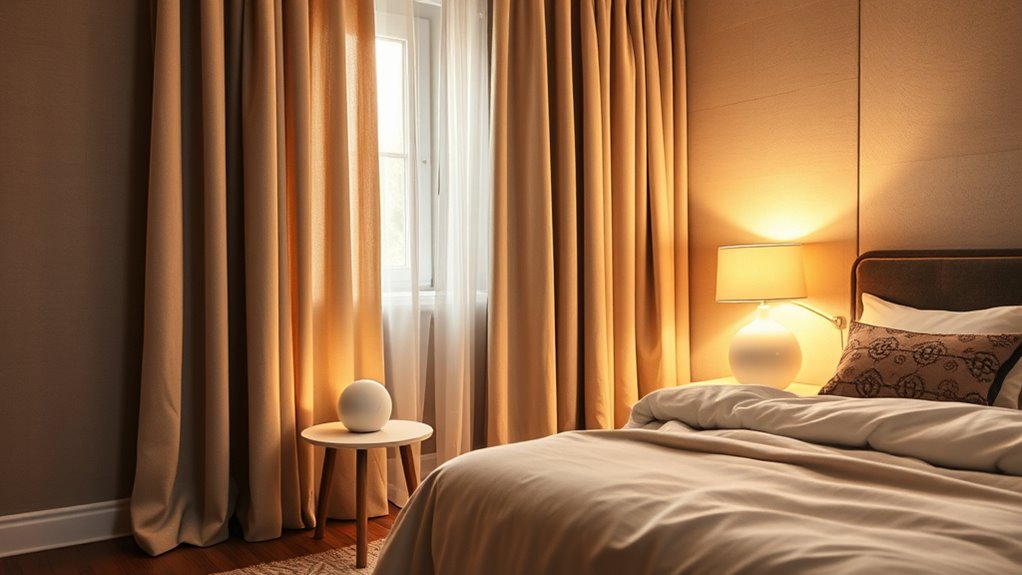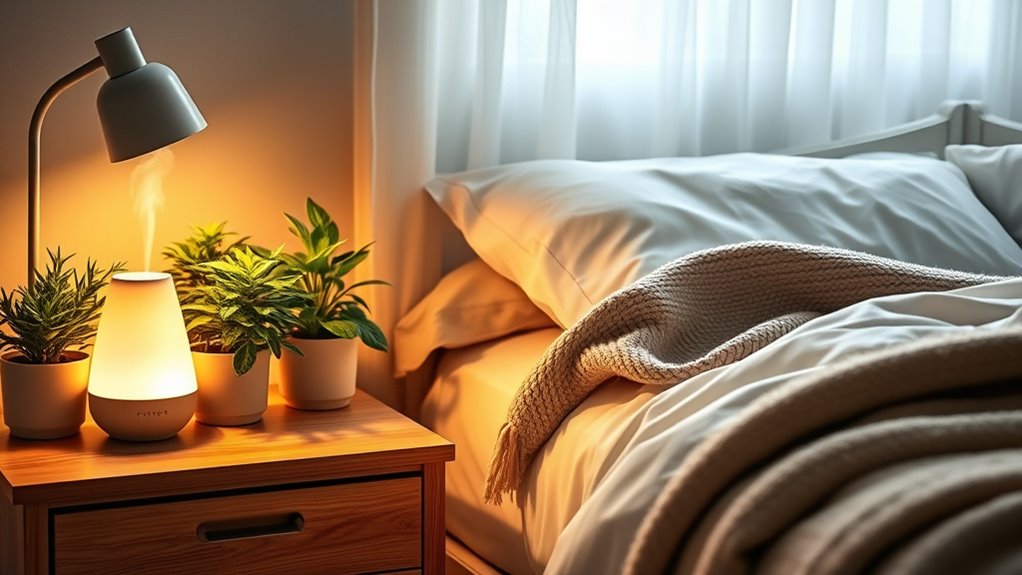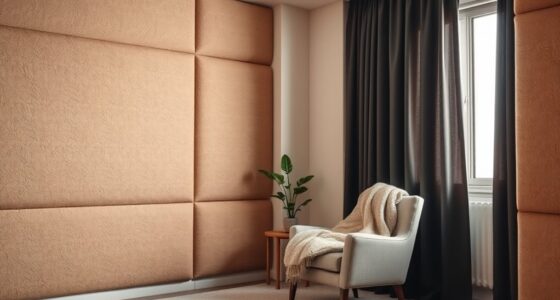By choosing calm, soothing colors like soft blues and greens, adding cozy textures, and keeping your space clutter-free, you create a relaxing environment that promotes better sleep. Incorporating warm, adjustable lighting, improving air quality with ventilation and plants, and using soundproofing or white noise helps minimize disruptions. Positioning your bed strategically and adding calming scents can further enhance your rest. Discover more ways to optimize your space for truly restful sleep as you explore these decorating habits.
Key Takeaways
- Maintaining a calm, organized space reduces visual clutter and minimizes stress, promoting better sleep quality.
- Using soothing colors like soft blues and greens creates a tranquil environment that encourages relaxation.
- Incorporating soft textures and cozy materials enhances sensory comfort and supports restful sleep.
- Optimizing lighting with warm, dimmable lights helps regulate circadian rhythms and signals the body to wind down.
- Improving air quality with plants and proper ventilation creates a healthier environment conducive to restful sleep.
Choose Soothing Colors to Promote Relaxation

Choosing the right colors for your bedroom can substantially impact your ability to relax and fall asleep. Soothing colors like soft blues and greens are proven to reduce stress and promote relaxation, making it easier to unwind at night. Experts recommend using muted, pastel shades in your bedroom decor because they create a tranquil environment that encourages rest. Bright or bold colors tend to be energizing and can disrupt your natural sleep cycle, so it’s best to avoid them in sleep spaces. Studies show that cool hues help lower heart rates, helping your mind and body prepare for sleep. Incorporating these soothing colors into your bedding, walls, and decor sets the psychological stage for restful sleep, making your bedroom a true sanctuary for relaxation. Additionally, understanding the difference between color psychology and other design principles can help you select hues that enhance your sleep environment effectively. Using appropriate color choices can further optimize your sleep quality by aligning your environment with your natural circadian rhythms. Paying attention to creative practice can inspire you to design a calming bedroom space that fosters relaxation and improves sleep quality. Moreover, selecting colors based on natural elements can deepen the connection to serenity and harmony in your space. Incorporating psychological effects of colors can also guide you toward hues that promote peaceful slumber and overall well-being.
Incorporate Soft Textures and Cozy Materials

Incorporating soft textures and cozy materials into your bedroom can substantially enhance your sense of comfort and relaxation. These tactile elements signal your brain that it’s time to unwind, helping you fall asleep faster. Soft textures like plush rugs, silky bedding, and cozy throws add sensory comfort, while materials such as cotton, wool, and linen promote breathability and warmth, creating a soothing sleep environment. Textured wall coverings or tactile pillows further stimulate your senses, encouraging relaxation. To keep your sleep environment healthy, regularly wash your soft bedding to reduce dust and allergens. Use the table below to explore different cozy materials and their benefits:
| Material | Texture | Benefit |
|---|---|---|
| Cotton | Soft, breathable | Promotes airflow, comfort |
| Wool | Warm, tactile | Insulates, relaxes senses |
| Linen | Cool, textured | Keeps environment fresh |
| Plush Fabrics | Ultra-soft, cozy | Enhances tactile sensation |
Minimize Clutter for a Calm Environment

Keeping your bedroom clutter-free helps your mind relax and fall asleep faster. Regularly removing unnecessary items and using smart storage solutions keeps your space tidy and peaceful. A clean environment reduces stress and creates a calming atmosphere for better rest. Incorporating vertical storage solutions can further maximize space and maintain an organized setting. Additionally, implementing home organization techniques creates a more serene environment conducive to restful sleep. Ensuring that your storage options are well-designed can help prevent clutter from accumulating again over time. Exploring various self watering plant pots can also add a touch of nature while maintaining a tidy space, as they help reduce the need for frequent watering and care. Understanding how beach destinations are curated for relaxation can inspire you to create a tranquil sanctuary in your own space.
Declutter Regularly
Regularly decluttering your bedroom helps create a calm environment by reducing visual chaos. When your space is free of clutter, it promotes organization and peace, making it easier to relax and fall asleep. A tidy room minimizes distractions, allowing your mind to unwind at bedtime. Plus, decluttering regularly prevents dust buildup and allergens, supporting healthier sleep. To visualize, consider this:
| Cluttered Space | Organized Space |
|---|---|
| Overstuffed drawers | Neatly folded clothes |
| Piled-up surfaces | Clear nightstands |
| Disorganized shelves | Tidy storage |
| Hidden messes | Visible, accessible items |
Making a habit of weekly decluttering fosters a sense of calm and transforms your bedroom into a true restful sanctuary, boosting your sleep quality. Incorporating storage solutions can further help maintain an organized space and support your decluttering efforts. Additionally, staying informed about market trends can motivate you to keep your environment clutter-free by focusing on your wellness goals. Regular decluttering also aligns with digital literacy programs that encourage maintaining a clean and organized personal space in the digital age. Developing a consistent decluttering routine can also strengthen your mindfulness practice, enhancing overall well-being. Incorporating essential oils for sleep into your bedtime routine can further enhance relaxation and improve sleep quality.
Use Storage Solutions
Using smart storage solutions can markedly reduce clutter and create a more tranquil bedroom. Vertical and underbed storage keep your space tidy, hiding clutter and promoting calm. Well-organized storage prevents dust and allergens from accumulating, improving air quality and supporting restful sleep. When your essentials are easy to access, bedtime frustration lessens, making it easier to relax. Consider these options:
- Hidden compartments for a clutter-free look
- Underbed storage for bulky items
- Shelving that keeps essentials within reach
Implementing natural materials in your storage furniture can further enhance the farmhouse ambiance and promote a sense of peace. Additionally, choosing air-purifying plants can naturally improve air quality and contribute to a healthier sleeping environment. Incorporating automation technology in your bedroom organization can also help maintain tidiness effortlessly and reduce remote work burnout by minimizing stress related to clutter.
Use Adjustable and Warm Lighting Options

Choosing dimmable, warm light bulbs helps create a relaxing atmosphere before bed. Incorporating multiple light sources allows you to adjust brightness and avoid harsh overhead lighting. This flexibility signals to your body that it’s time to wind down, improving your sleep quality.
Opt for Dimmable Lights
Dimming your lights in the evening signals to your body that it’s time to relax, helping you wind down more easily. Using dimmable lights allows you to gradually reduce brightness, promoting melatonin production and easing the shift to sleep. Creating a sleep environment with warm-colored dimmable lighting, like amber or low-wattage bulbs, fosters coziness and relaxation. These adjustments support your circadian rhythm by mimicking natural sunset cues, making it easier to fall asleep. Incorporating sleep-friendly lighting can further enhance your sleep environment and overall rest quality. Additionally, understanding the importance of quality assurance in your sleep setup can help you choose reliable lighting products that meet safety and durability standards.
Use Warm Light Bulbs
In the evening, switching to warm light bulbs with low color temperatures (around 2700K) can substantially boost melatonin production, making it easier for you to fall asleep. Warm light creates a calming lighting atmosphere that signals to your brain it’s time to wind down. Using adjustable lighting options allows you to transition from brighter, cooler lights during the day to softer, warmer lights at night, supporting your circadian rhythm. Dimmable warm lighting further enhances this effect by reducing alertness and promoting relaxation. Replacing harsh overhead lighting with warm, ambient lamps minimizes blue light exposure in the evening, which can interfere with sleep quality. By paying attention to your lighting choices, you can create an environment that naturally encourages restful sleep.
Incorporate Multiple Light Sources
Incorporating multiple light sources, such as bedside lamps, dimmable ceiling lights, and accent lighting, allows you to customize your environment to promote relaxation before sleep. Layered lighting helps you adjust lighting levels to create a calming atmosphere that signals your body to wind down. Warm-colored bulbs with low brightness lower melatonin suppression, supporting your natural sleep cycle. Adjustable lighting options let you gradually dim lights in the evening, fostering a soothing environment. This reduces harsh shadows and glare, minimizing visual stress. You’ll feel more at ease, making it easier to shift into restful sleep.
- Create cozy, inviting spaces that soothe your mind
- Reduce visual stress with gentle, layered lighting
- Signal your body to relax with warm, adjustable lighting
Enhance Air Quality With Ventilation and Plants

Improving your indoor air quality starts with good ventilation and the strategic use of houseplants. Proper ventilation helps clear out pollutants and allergens, supporting better sleep and reducing respiratory issues. Opening windows for a few minutes daily refreshes the air and maintains ideal humidity, which prevents mold growth and dust mites that can disturb your sleep. Incorporating houseplants like aloe vera, snake plant, or peace lily naturally purifies the air by removing toxins such as formaldehyde and benzene. Together, ventilation and houseplants work to create a healthier sleeping environment by reducing airborne irritants. Using these simple strategies enhances air quality, making your bedroom a more comfortable and restorative space each night.
Manage External Noise With Soundproofing or White Noise

External noise can markedly disrupt your sleep, making it harder to fall asleep and stay asleep through the night. To manage external noise, consider soundproofing your bedroom with double-glazed windows or acoustic panels that block out unwanted sounds. Using white noise machines or fans creates a consistent background sound that masks external noise, helping you relax and drift off faster. Thick curtains and rugs also absorb sound waves, reducing noise levels further. Taking these steps can turn your bedroom into a peaceful sanctuary. Imagine:
Soundproof your bedroom with double-glazed windows and white noise to enjoy peaceful, uninterrupted sleep every night.
- Falling asleep quickly without interruptions
- Waking up feeling refreshed and well-rested
- Enjoying a quiet, calming environment every night
Create a Fresh and Inviting Scented Atmosphere

Creating a calming scented atmosphere in your bedroom can substantially enhance your ability to relax and fall asleep. Aromatherapy with essential oils like lavender, bergamot, or geranium can boost relaxation and improve sleep quality. Using a diffuser or placing scented sachets near your bed allows you to enjoy these tranquil scents consistently. Studies show that lavender, in particular, helps increase slow-wave sleep and reduces disturbances. Be mindful to choose subtle, natural fragrances over overpowering ones to avoid overwhelming your senses. Regularly revitalizing your scented environment maintains a soothing ambiance that signals your body it’s time to rest. By creating this inviting scent atmosphere, you set the stage for a more restful and restorative sleep experience every night.
Position Your Bed for Comfort and Security

Positioning your bed thoughtfully can considerably enhance your sense of security and comfort while you sleep. When you choose the right position, you create a sanctuary that promotes relaxation and peace of mind. Place your bed in the “command position,” ideally facing the door but not directly in line with it, so you feel in control. Position the head of your bed against a solid wall for added support and reduced vulnerability. Avoid putting your bed under windows or near loud external sources, which can disturb your rest. Ensure there’s enough space around your bed for easy movement and to prevent clutter. Use bedside tables on both sides to create balance, stability, and a sense of order that supports restful sleep.
Frequently Asked Questions
What Are Some Effective Habits for Improving Sleep?
To improve your sleep, establish a consistent bedtime routine that includes turning off screens an hour before bed. Create a cozy, dark, and cool environment with dim lighting and blackout curtains. Limit noise and guarantee good air circulation. Incorporate relaxing scents like lavender to reduce stress. These habits help reinforce your body’s natural rhythms, making it easier to fall asleep faster and enjoy deeper, more restorative rest.
What Improves Quality of Sleep?
Imagine your sleep as a delicate garden that needs nurturing. To improve its bloom, you create a peaceful environment. Keep your room dark with blackout curtains, like a moonless night, and cool like a gentle breeze. Minimize noise as if silencing a busy street. Use calming scents like lavender, and choose cozy, clutter-free bedding. These steps help your sleep garden flourish, giving you restorative rest every night.
What Is the Simple Habit That Leads to Better Sleep?
You want a simple habit for better sleep, right? Try creating a calming pre-sleep environment. Dim the lights, keep your room cool, and add relaxing scents like lavender. These small changes signal to your brain that it’s time to unwind, making it easier to fall asleep and stay asleep longer. Consistently practicing this habit helps improve your overall sleep quality and leaves you feeling refreshed each morning.
What Is the 10 5 3 2 1 Rule for Sleep?
So, you’re wondering about the 10 5 3 2 1 rule for sleep? It’s your secret weapon to outsmart bedtime chaos! You cut screen time an hour before, skip caffeine and heavy meals 2-3 hours prior, and hit the sack at the same time every night. Add calming routines, like dimming lights, and you’ll be snoozing soundly, no magic wand needed. Sleep success is all about smart, simple habits!
Conclusion
By making these simple decorating changes, you can turn your bedroom into a restful retreat. For example, imagine someone who added calming colors and cozy textures—within weeks, they noticed falling asleep faster and waking up refreshed. Small tweaks like choosing warm lighting or adding a plant can have a big impact on your sleep quality. So, start creating a peaceful space today, and enjoy the restful nights you deserve.









